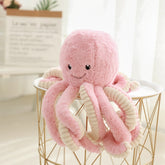How to Make Plush Toys Soft Again: Revitalizing Your Child’s Cuddly Companions
Table of Contents
- Introduction
- Why Do Plush Toys Lose Their Fluffiness?
- How to Make Plush Toys Fluffy Again
- Daily Care Tips for Your Plush Toys
- Conclusion
- FAQs
Introduction
Have you ever stumbled upon a beloved plush toy that has lost its once-adorable fluffiness? Whether it's due to countless hugs, adventures, or just the passage of time, many of us have faced the heart-wrenching moment when our child's favorite stuffed animal seems to have lost its charm. In fact, studies show that children often develop strong emotional attachments to their plush toys, making the need to restore them even more significant for parents and guardians alike.
At Baby Kid Squad, we understand the importance of these cherished companions. Our mission is to make parenting a little easier and a lot more stylish. We are committed to helping families navigate the journey of childhood with confidence and flair, which includes caring for those beloved plush toys. In this blog, we will explore effective and practical methods on how to make plush toys soft again, ensuring they remain huggable and comforting for years to come.
By the end of this post, you will learn various techniques to revive the softness of your child's plush toys, from gentle cleaning methods to fluffing strategies. We will also discuss daily care tips to help maintain their plush quality and address common concerns parents may have regarding the upkeep of these treasured items. Whether you're dealing with a well-loved teddy bear or a recently acquired softie, our guide is designed to equip you with all the information needed to keep their plush companions in top condition.
Let’s dive into the world of plush toy care, where we will uncover the secrets to restoring the softness of your child’s cuddly friends while ensuring they continue to be a source of comfort and joy.
Why Do Plush Toys Lose Their Fluffiness?
Every plush toy has its own story, but many face a common fate: they lose their softness and charm over time. Understanding the reasons behind this decline can help us implement better care practices. Here are some key factors contributing to the loss of plush toys' fluffiness:
Frequent Washing
Washing plush toys is essential for hygiene, especially for items that are frequently hugged and snuggled. However, excessive washing can lead to the stuffing becoming compressed over time. The repeated agitation can cause the fibers to lose their bounce, resulting in a flat or lumpy appearance.
Long-Term Use
Like any item that gets daily use, plush toys experience wear and tear. As they are squeezed, hugged, and played with, the filling can become flattened, especially in high-pressure areas such as limbs and heads.
Improper Storage
Storing plush toys in tight spaces or in damp environments can lead to clumping and a loss of fluffiness. Over time, improper storage can compress the stuffing and cause fibers to lose their original softness.
Improper Drying Techniques
After washing, plush toys need to be dried properly to maintain their softness. Exposure to high heat or direct sunlight during drying can shrink fibers and damage stuffing. Instead, air-drying or using low-heat settings is preferable.
Understanding these factors empowers us to take action and implement maintenance strategies that can help preserve the plushness of these cherished toys.
How to Make Plush Toys Fluffy Again
Now that we understand the reasons plush toys lose their softness, let’s explore the various methods we can use to restore their fluffiness. From simple hand-fluffing techniques to more involved washing methods, we have you covered!
1. Gentle Hand-Fluffing
One of the simplest and most effective ways to restore a plush toy’s fluffiness is manual fluffing. By gently massaging and squeezing the toy, we can loosen and redistribute the filling inside:
- How to Do It: Hold the plush toy in one hand and gently knead the surface, focusing on areas that have become flat. Use your fingers to gently push the stuffing back into place and break up any clumps.
- Benefits: This method is quick and requires no additional materials, making it perfect for a fast fluff-up right before bedtime.
2. The Hairdryer Method
If hand-fluffing isn’t enough, using a hairdryer can work wonders by gently separating the fibers in the fabric:
- How to Do It: Set your hairdryer to a low or medium heat setting and hold it a few inches away from the toy. Move the dryer in a circular motion over the surface while gently massaging the toy with your hands.
- Benefits: This method helps to restore the plush toy's shape without the risk of damaging the material, as long as we avoid high heat.
3. Tumble Drying with Dryer Balls
For toys that can withstand machine drying, the tumble dryer can be a game-changer. Using dryer balls or clean tennis balls can help fluff up the filling:
- How to Do It: Place the plush toy in the dryer alongside a couple of dryer balls. Set the dryer to a low heat or "air fluff" setting and let it tumble for 10-15 minutes.
- Benefits: The balls bounce around, breaking up any clumps and revitalizing the stuffing, making the plush toy feel brand new again.
4. Freezing for Fluffiness
Believe it or not, freezing a plush toy can help restore its fluffiness by firming up the stuffing:
- How to Do It: Place the plush toy in a large plastic bag and seal it tightly. Put it in the freezer for several hours, preferably overnight. Afterward, gently squeeze and fluff the toy by hand.
- Benefits: This method is particularly useful for soft toys with synthetic filling, as the cold can help to re-energize the fibers.
5. Re-Stuffing for a Plush Makeover
If a plush toy is exceptionally flat, it may be time for a stuffing upgrade:
- How to Do It: Carefully open a seam at the back or bottom of the toy, remove the old stuffing, and refill with fresh polyester fiberfill. Ensure not to overstuff, to maintain a soft and cuddly feel.
- Benefits: This method can provide a plush toy with an entirely new lease on life, making it feel as good as new.
6. Proper Washing Techniques
When it’s time for a deep clean, washing plush toys correctly is crucial to maintaining their softness:
- How to Do It: Check the care label first. If machine washable, place the toy in a mesh laundry bag and use a gentle cycle with cold water and mild detergent. Avoid washing too frequently; only do so when necessary.
- Benefits: Proper cleaning removes dirt and odors without compromising the toy’s fluffiness, ensuring it remains a comforting presence for your child.
7. Fabric Softener Magic
Using fabric softener can help restore the plush material's softness:
- How to Do It: Mix one part fabric softener with three parts water in a spray bottle. Lightly mist the plush toy, and use a soft brush to work the softener into the fibers. Allow it to air dry completely.
- Benefits: The fabric softener relaxes the fibers, making the plush toy smoother and more cuddly.
Daily Care Tips for Your Plush Toys
While we now know how to restore the softness of plush toys, maintaining their plush quality is equally important. Here are some daily care tips to keep your child's plush companions looking and feeling great:
1. Regular Light Cleaning
Instead of frequent washing, focus on light cleaning. Gently pat the toy to remove dust and use a soft brush to keep the fur fluffy. Spot cleaning with mild detergent is also a good alternative when needed.
2. Proper Storage
Store plush toys in a dry, cool place to keep them in top condition. Avoid direct sunlight, as this can fade colors and degrade the fabric. Use breathable bags or containers to protect them from dust and dirt.
3. Routine Maintenance
Regularly patting and brushing plush toys can help keep the fabric looking fresh and prevent matting. Check the stuffing periodically; if it starts to shift or flatten, consider adding more filler to restore its original plushness.
4. Rotation and Display Care
If your plush toys are part of a collection or displayed, try rotating them occasionally. This prevents prolonged pressure on certain areas, ensuring even fluffiness and avoiding deformation.
Conclusion
Restoring the softness of plush toys is not only a practical endeavor; it’s a way to preserve memories and maintain the comfort these beloved companions provide. Armed with the right techniques and regular care, we can ensure that our children’s plush friends remain cuddly and inviting for years to come.
At Baby Kid Squad, we believe that caring for these cherished items is a vital part of parenting. By following the methods outlined in this blog, we can breathe new life into those well-loved plush toys, making them feel as good as new.
Should you need to replace or expand your collection of stuffed animals, we invite you to explore our curated collections at Baby Kid Squad, where you’ll find a variety of stylish, high-quality plush toys designed to bring joy and comfort to your child.
FAQs
Q1: Can I wash all plush toys in the washing machine?
A1: Not all plush toys are machine washable. Always check the care label for specific washing instructions. For those labeled "Surface Wash Only," stick to spot cleaning.
Q2: How do I clean plush toys with electronic parts?
A2: If possible, remove the electronics first. For toys that can’t be submerged, gently wipe the surface with a damp cloth or use a steam cleaner for cleaning.
Q3: Are there any natural alternatives to fabric softener?
A3: Yes! A mixture of vinegar and water can act as a natural softener. Be sure to test on a small area first to ensure compatibility with the plush material.
Q4: How often should I clean my plush toys?
A4: The frequency of cleaning depends on usage and environment. For toys that are frequently cuddled, a gentle cleaning every few months is usually sufficient. For toys exposed to more dirt, more frequent cleanings may be necessary.
By keeping these tips in mind, we can ensure that our children's plush toys remain soft, cuddly, and ready for all of life's adventures.









